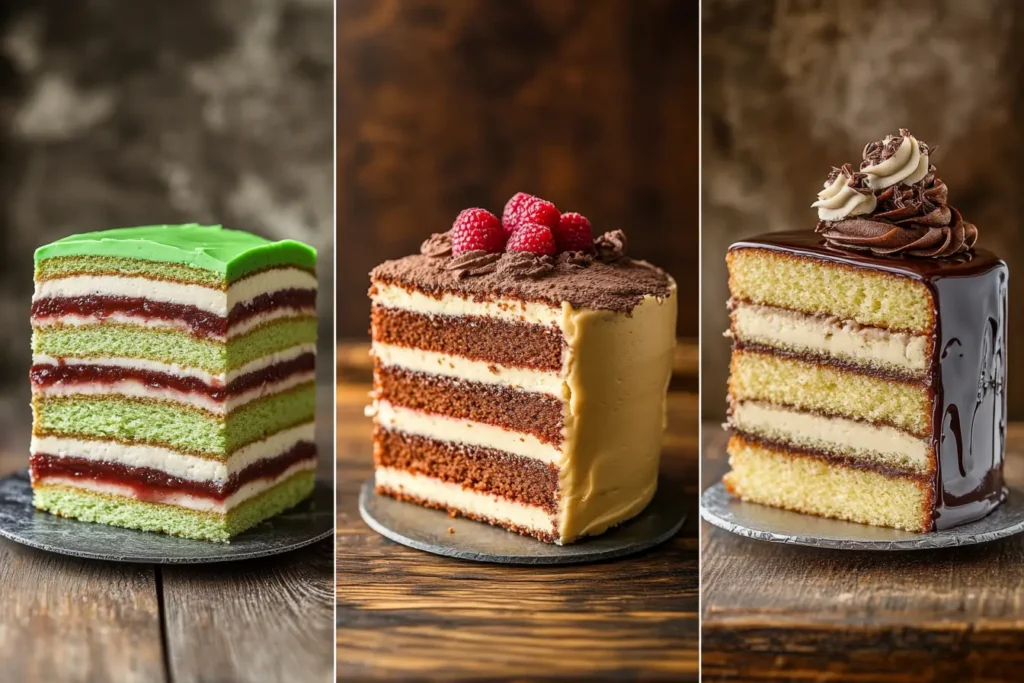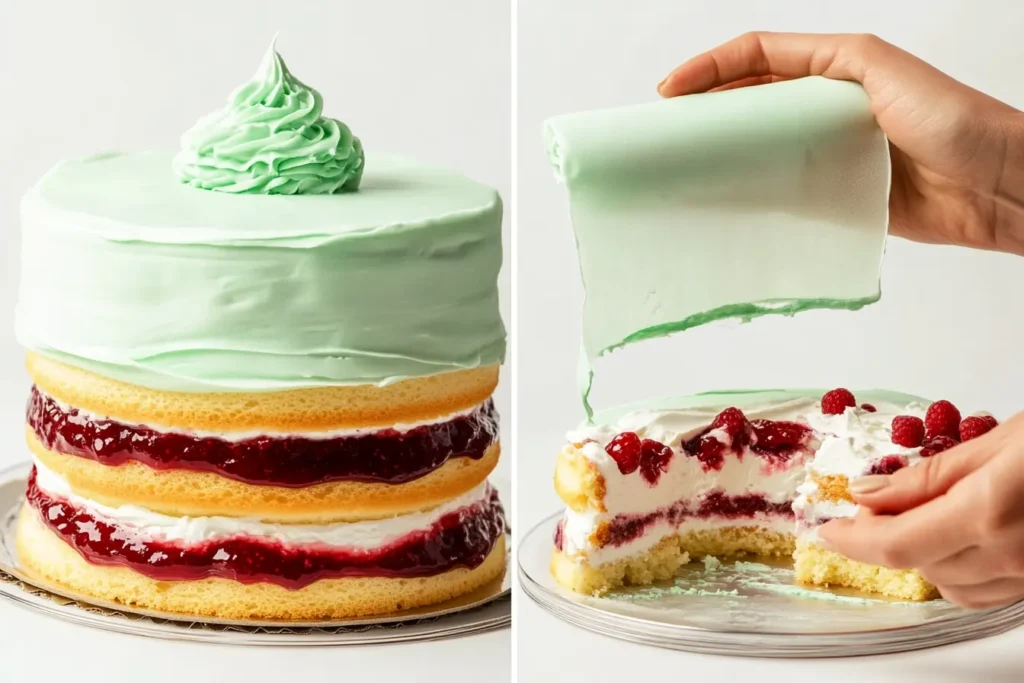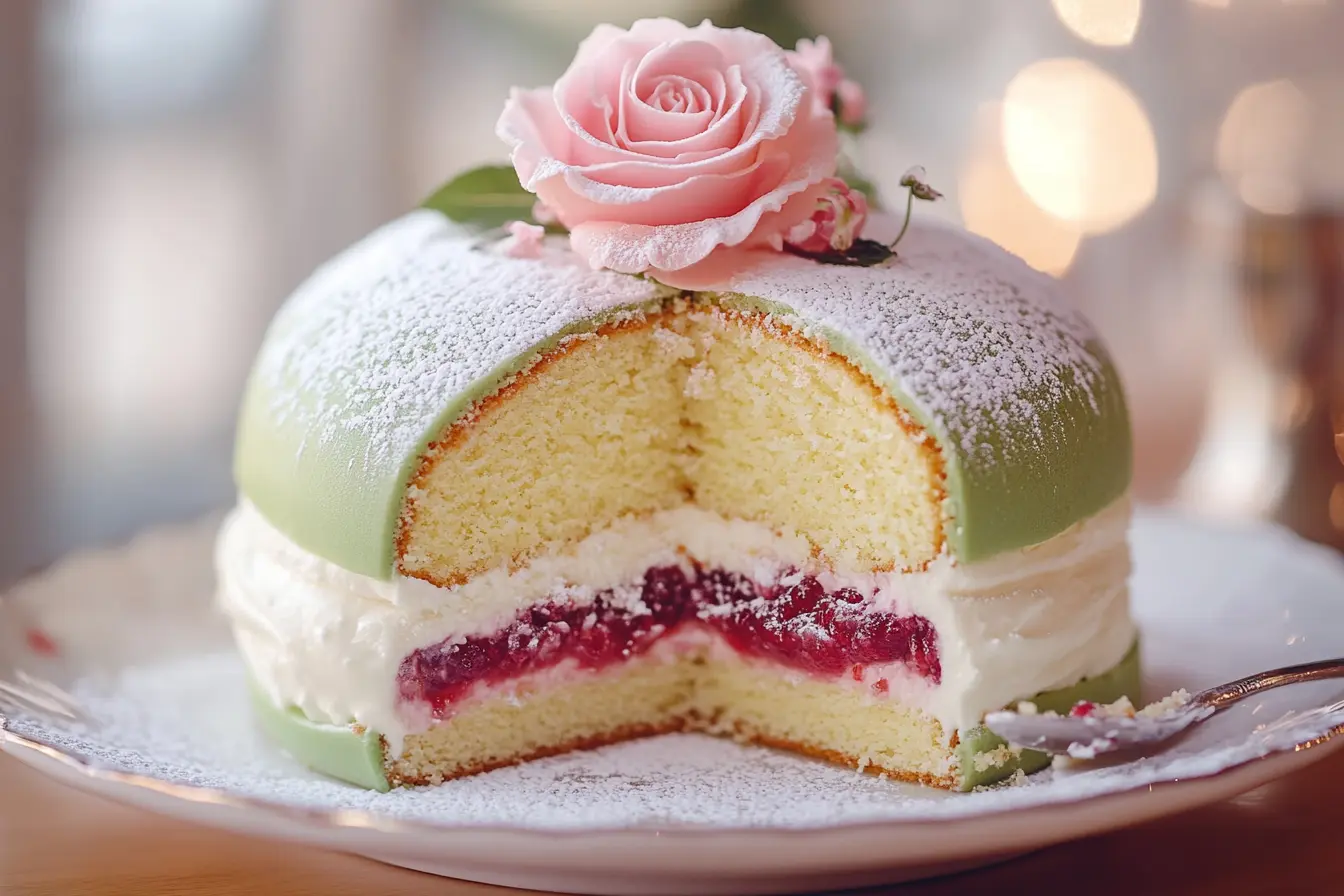Introduction
Few desserts are as elegant and intriguing as Princess Cake, a Swedish classic known for its light, creamy texture and signature green marzipan dome. But what flavor is Princess Cake exactly? Is it fruity, nutty, or sweet?
This delightful cake is a harmonious blend of vanilla custard, raspberry jam, almond-flavored marzipan, and airy whipped cream, all layered over a soft sponge cake. The result? A sweet, nutty, slightly tangy flavor with a silky finish.
In this article, we’ll uncover the distinct flavors that make Princess Cake so special, compare it to other famous cakes, explore the role of bakery emulsions, and share tips on how to achieve the authentic taste. If you’ve ever wondered why this cake is so beloved, you’re about to find out!
Let’s start by breaking down its unique flavor profile.
Understanding the Flavor of Princess Cake
The Signature Taste of Princess Cake
So, what flavor is Princess Cake? It’s a delicate balance of sweet, nutty, and slightly tart notes, creating a truly unique taste experience. Here’s what makes it stand out:
- Sweet & Creamy: The vanilla custard and whipped cream add a light yet indulgent sweetness.
- Nutty & Rich: The almond-flavored marzipan gives it a distinct nutty taste.
- Fruity & Tart: A layer of raspberry jam provides a burst of tartness, balancing the sweetness.
- Light & Airy: The sponge cake keeps the cake fluffy, preventing it from being overly dense.
This combination of flavors and textures is what makes Princess Cake both luxurious and refreshingly light at the same time.
Key Ingredients That Define Its Flavor
Each component of a Princess Cake plays a crucial role in shaping its taste. Let’s take a closer look at these ingredients:
- Sponge Cake: A classic vanilla sponge forms the base, providing a neutral, slightly sweet foundation.
- Vanilla Custard: This rich, creamy filling adds a deep vanilla flavor that blends seamlessly with the cake.
- Whipped Cream: Airy and delicate, it makes the cake feel light and fluffy.
- Raspberry Jam: A thin layer of tart raspberry jam adds a subtle fruitiness that balances the sweetness.
- Marzipan Covering: The signature green marzipan provides a nutty almond finish, giving the cake its distinctive flavor.
The combination of these flavors is what makes Princess Cake so iconic and unforgettable.
Princess Cake vs. Other Classic Cakes
When it comes to classic European desserts, the Royal Cake stands out for its light yet rich flavor combination. But how does it compare to other well-loved cakes? Let’s take a look!
How Does Princess Cake Compare to Other Desserts?
So, what flavor is Princess Cake when compared to other cakes? It offers a harmonious blend of sweet, nutty, and slightly tart flavors, but how does that stack up against other famous confections?
- Princess Cake vs. Victoria Sponge:
- Victoria Sponge consists of vanilla sponge, jam, and buttercream, creating a sweet and buttery taste.
- In contrast, Princess Cake has a more complex flavor, thanks to the almond notes from marzipan and the airy whipped cream layer.
- Princess Cake vs. French Entremets:
- French entremets use multiple mousse and cake layers, often featuring rich chocolate, coffee, or fruit flavors.
- The lighter and nuttier profile of Princess Cake makes it less intense but equally indulgent.
- Princess Cake vs. Italian Millefoglie:
- Millefoglie, also known as Mille-feuille, features crispy pastry layers with pastry cream filling, making it more buttery and crunchy.
- Princess Cake, on the other hand, has a fluffier texture due to the whipped cream and soft sponge cake layers.
Each of these cakes is delicious in its own way, but the balance of flavors in Princess Cake makes it a truly unique treat!

Is Princess Cake Always Green?
Traditionally, a Princess Cake is wrapped in green marzipan, but is that the only version? Not at all!
- Green Marzipan (Classic Version): This is the most traditional form, giving the cake its signature look and almond-forward flavor.
- Pink & Yellow Marzipan: Some bakeries swap out the green for pastel pink or yellow, offering a more delicate aesthetic.
- Chocolate-Coated Princess Cake: A few variations use chocolate marzipan or ganache instead of marzipan, creating a richer, deeper flavor.
No matter the color, the flavor profile remains the same, with its nutty, creamy, and slightly tart balance.
The Role of Flavoring Emulsions in Princess Cake
While traditional Princess Cake gets its signature taste from custard, jam, and marzipan, some modern bakers use flavor emulsions to enhance its depth.
What Is Princess Cake & Cookie Emulsion?
If you’ve ever baked with flavored extracts, you might wonder how emulsions compare. A flavoring emulsion is a concentrated, water-based flavoring that’s often used in professional baking.
So, what flavor is Princess Cake when enhanced with flavor emulsions? These emulsions often include a mix of:
- Vanilla: Adds a sweet, warm, and creamy base flavor.
- Almond: Enhances the nutty undertones, making the marzipan layer more pronounced.
- Citrus Zest: A slight hint of lemon can bring out fresh, bright notes that complement the raspberry jam.
These emulsions ensure that the flavor remains strong, even after baking or refrigeration.
How Professional Bakers Enhance the Flavor
Many pastry chefs use flavor emulsions to make sure that the flavors of Princess Cake are perfectly balanced. Here’s why they prefer them over traditional extracts:
- More Intense Flavor: Since emulsions are water-based instead of alcohol-based, they don’t “bake out” as extracts do.
- Better Mixing: They blend more smoothly into pastry cream, sponge cake, and whipped cream, creating a uniform taste.
- Consistency: Professional bakeries rely on emulsions to maintain the same flavor in every batch.
While traditional Princess Cake doesn’t require emulsions, they can be a useful tool for home bakers looking to intensify the cake’s vanilla-almond-citrus notes.
How to Make Princess Cake Taste Authentic
If you’ve ever wondered, what flavor is Princess Cake and how to recreate it at home, the secret lies in using the right ingredients. The delicate balance of sweetness, nuttiness, and tartness is what makes this cake so special. Let’s break down how to achieve its signature flavor.
Choosing the Right Ingredients for Flavor
Each component of Princess Cake contributes to its unique taste and texture. To make an authentic version, be sure to use:
- Sponge Cake: A light vanilla sponge serves as the base, providing structure without overwhelming the other flavors.
- Vanilla Custard: This rich, creamy layer gives the cake its deep vanilla flavor, complementing the sponge.
- Whipped Cream: The whipped cream adds lightness and ensures the cake doesn’t feel too dense.
- Raspberry Jam: A layer of slightly tart raspberry jam adds contrast to the sweet cream and marzipan.
- Marzipan: The defining feature of Princess Cake, marzipan adds a nutty almond flavor and provides a smooth, elegant finish.
Using high-quality ingredients makes all the difference. Fresh cream, pure vanilla extract, and real almond marzipan elevate the cake’s flavor, making it as authentic as possible.
Tips for Achieving the Perfect Balance
While the ingredients create the foundation, how you put them together is just as important. Here are some pro tips to ensure your Princess Cake tastes just right:
- Control the sweetness: Too much jam or sugar in the custard can overpower the almond notes of the marzipan. Use a balanced ratio to keep the flavors in harmony.
- Keep the whipped cream light: Over-whipped cream can make the cake feel heavy. Aim for soft peaks to maintain its signature airy texture.
- Don’t overdo the marzipan: While marzipan is key to the flavor, a thick layer can be overwhelming. Roll it thin for the perfect balance of nutty and sweet.
By carefully selecting ingredients and balancing flavors, you can create a Princess Cake that tastes just like the traditional Swedish version.

Fun Facts & Lesser-Known Details About Princess Cake
Beyond its delicate layers and rich flavors, the Princess Cake has some fascinating history and fun facts that add to its charm.
Did You Know?
- It was originally reserved for Swedish royalty! The cake was once considered a luxury and was mainly enjoyed by the Swedish royal family before becoming widely available.
- Sweden is one of the largest consumers of marzipan. The Princess Cake is a big reason why marzipan remains so popular in Scandinavian desserts.
- There’s a whole week dedicated to it! Every year, Sweden celebrates Princess Cake Week, where bakeries showcase their best versions of this classic treat.
Records and Unique Variations
- The largest Princess Cake ever made weighed over 300 pounds and was created for a Swedish festival.
- Some bakers now make vegan and gluten-free versions, using plant-based creams and alternative flours.
- In modern pastry trends, some versions swap green marzipan for chocolate or even edible gold, giving the cake a luxurious makeover.
The Princess Cake continues to evolve and inspire pastry lovers worldwide. But no matter how many versions exist, the original vanilla, raspberry, and almond flavor combination remains the heart of this beloved dessert.
FAQs – What People Also Ask
Many people are curious about what flavor is Princess Cake and how it compares to other desserts. Below are some of the most frequently asked questions about this classic Swedish treat.
What Flavor Is Princess Cake?
A Princess Cake has a delicate yet distinct balance of flavors. The sweet vanilla custard, airy whipped cream, and tart raspberry jam blend together beautifully, while the almond-rich marzipan gives it a nutty finish. The combination creates a light, creamy, and slightly tangy taste that makes this cake so beloved.
Does Princess Cake Always Have Raspberry Jam?
Traditionally, raspberry jam is a key ingredient in Princess Cake, adding a tart contrast to the sweet and creamy layers. However, some variations use strawberry, apricot, or lingonberry jam, though purists insist that raspberry is the authentic choice.
What Does Princess Cake Emulsion Taste Like?
Bakers sometimes use Princess Cake emulsion, a concentrated flavoring, to enhance the cake’s sweet, nutty, and citrusy notes. This emulsion usually contains vanilla, almond, and lemon essence, helping to bring out the signature flavors of the cake without overpowering it.
Can I Make a Princess Cake Without Marzipan?
Yes! While marzipan is a defining feature, some bakers substitute it with fondant, buttercream, or chocolate ganache. However, without the almond-flavored marzipan, the cake loses part of its signature taste and texture.
Conclusion – A Cake Fit for Royalty
Now that we’ve explored what flavor is Princess Cake, it’s clear why this beloved Swedish dessert has stood the test of time.
Why the Princess Cake Remains a Timeless Favorite
- The balanced combination of sweet, nutty, and tart flavors makes it unique yet universally loved.
- Its light and airy texture makes it feel indulgent without being too heavy.
- The green marzipan dome gives it a signature look, instantly recognizable in bakeries worldwide.
- It’s a staple at Swedish celebrations, from birthdays and weddings to traditional fika breaks.
A Dessert Worth Trying
If you’ve never tasted a Princess Cake, now’s the perfect time! Whether you find it in a Scandinavian bakery or make it at home, this classic cake is sure to impress. The next time someone asks, what flavor is Princess Cake, you’ll know it’s a delicate mix of vanilla, almond, and raspberry with a touch of creaminess—truly a dessert fit for royalty!
💡 Want to discover more classic European desserts? Check out our recipe collection for more sweet inspiration! 🍰✨

